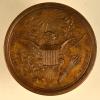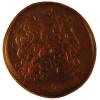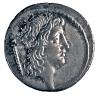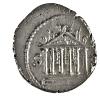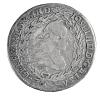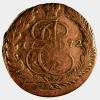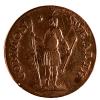You are here
The Eagle: The Flip Side of Liberty
The 1792 Mint Authorization Act mandated that an eagle be placed on the reverse of all precious metal denominations. Like the image of Liberty, the eagle as a coin type had many classical and early modern precedents. Its associations, however, were with military and imperial might rather than ideals of independence and republicanism. It became an American national symbol largely through its selection, after a long series of deliberations by successive congressional committees, as the main device on the Great Seal.
|
Paul Revere (1735–1818). View of the Obelisk Erected under Liberty-tree in Boston on the Rejoicings for the Repeal of the Stamp Act. Etched printing plate, 1766; restrike, 1943. In 1766 Paul Revere designed an obelisk to be erected under the “Liberty Tree” in Boston to celebrate the repeal of the Stamp Act, the principal incitement to rebellion in the colonies. He engraved a copper printing plate with the text and images of the obelisk, which were mainly common motifs of the culture of the American colonies. The figure of Liberty appears twice in the image: in the left panel as a winged woman holding her staff with the cap on top of it, and in the right panel as a maiden in contemporary dress, also with staff and cap, accompanied by Britannia and by America represented as an Indian maiden. |
|
Bernard de Montfaucon (1655–1741). Antiquity Explained, and Represented in Sculptures. Translated by David Humphreys. Volume 4. London: J. Tonson and J. Watts, 1721–1722. In the Roman world the symbol of the eagle was largely associated with the standards of various military legions. |
|
Joachim Camerarius (1534–1598). Symbolorum et emblematum. Mainz: Bourgeat, 1712. This emblem book explains that the eagle holds a thunderbolt in its left talons and an olive branch in its right as a reminder that it officiates over war and peace. |
|
Pierre Eugène Du Simitière (ca. 1736–1784). Charles Thomson. Plate 5 from Collection des portraits. . . . Paris, 1781. On July 4, 1776, Congress established a committee to create a seal for the new nation, appointing Benjamin Franklin, Thomas Jefferson, and John Adams as members and Pierre Eugène Du Simitière as its secretary. The proposals by the three regular members were considered inappropriate, but Du Simitiere’s suggestion for a compound shield representing the lands from which Americans had emigrated became the basis for future deliberations. In it, Germany was represented by a small eagle. As subsequent committees considered alternatives, the eagle became increasingly prominent and the principal element in the draft of the third committee in 1782. Charles Thomson, Secretary of the Continental Congress, combined the ideas of the three successive committees to produce the basis of the final shield. In this design, the eagle was the central device, bearing a shield on its breast and the symbols of peace and war in its talons; in its beak the eagle held a scroll with the motto of E PLURIBUS UNUM, another of Du Simitière’s contributions to American numismatics. |
|
James Trenchard (b. 1747). Arms of the United States. The Columbian Magazine 1 (September 1786–May 1787). The Great Seal of the United States was first used on a document of September 16, 1782, issued from Nassau Hall, Princeton, which was then the nation's capital following mutinous disturbances by soldiers in Philadelphia. |
|
Augustin Dupré (1748–1833). Diplomatic Medal. Bronze original, 1791. Secretary of State Thomas Jefferson commissioned this medal in 1790, shortly after having returned from his service as ambassador to France. It was intended as a Gift for French diplomats who had aided the American cause. The two examples that were awarded in gold are not extant, presumably having been melted when their aristocratic recipients fled in the wake of the French Revolution. Only three examples of the original striking in bronze are known; Princeton’s specimen is the only one in a public collection. |
|
Augustin Dupré. Diplomatic Medal (1791). Bronze restrike, ca. 1876. |
Case Group 10A
|
|
|
|
Case Group 10B
|
|
|
|
|
|






